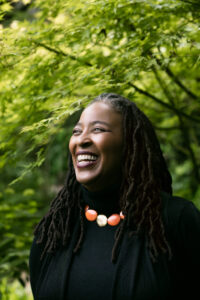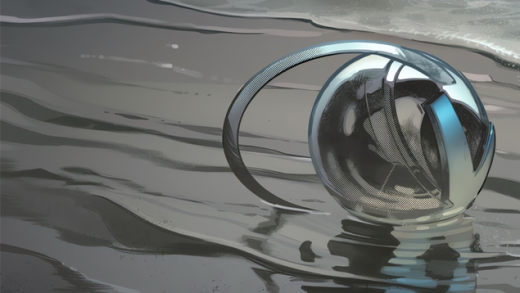Like many readers, I came to Camille T. Dungy first through her poetry, but her recent nonfiction writing has expanded my sense of her artistry. I devoured Guidebook to Relative Strangers, a memoir about race, travel, and mothering, and was thrilled to learn that Dungy is also a gardener: a woman after my own heart. In her new book, Soil, she takes her trowel to the issues of justice, wilderness, brutality, and neighborliness, and the garden that blooms through her sentences is both captivating and sobering. In our conversation, I felt lucky to pick her brain about how her concerns—for both humans and our earth—are knotted together.
Katy Simpson Smith: I had the great pleasure of reading this book in my own mother’s garden, surrounded by the first blooms of spring: tiny daffodils, blue-eyed grass, wild onions.
Camille T. Dungy: You’re in spring already!? Jealous. We still have a few more weeks before we start to see the very earliest sprouts and blooms.
KSS: Ah, what will be the first flowers to emerge for you in Fort Collins?
CTD: There are these lovely tiny crocus-like flowers called pasqueflowers. They are purple with yellow centers. Love them so. They usually come up around Easter.
KSS: When did you first understand gardens as a space of beauty you had access to? As you began to build your own, how did you come to view the garden as a foundation for your writing?
CTD: This is truly my first garden. I’ve always had potted plants inside the house, and I have done things here and there in rented spaces with container gardens or short-lived projects in the soil. But this house has been my first opportunity to really make the outside space our own. That said, I’ve always loved visiting municipal gardens and other garden spaces. Those can bring a kind of peace as well. More so, perhaps, because I don’t have to be the one thinking about maintenance!
I’m not sure I think about the garden as a foundation for my writing. In fact, often they feel like oppositional forces, both demanding time and attention, and when my time is short, one or the other tends to get less of me. But what I do believe is that it is important to write about life as it is actually lived. And I spend a lot of time in my garden, so if I am writing about my life then I am also writing about my garden.

KSS: That’s what feels so new and resonant to me in this book—the entwined quality of the human and natural worlds, and your sense that any separation between them is artificial. You describe what you’re after as “a radically domestic ecological thought.” What do you see as this book’s intervention, and why is this interconnectedness something we need to be paying attention to now?
CTD: In my own life the separation does seem artificial. I think this may have something to do with my living in the West. Here, even in many urban areas, you can’t escape the stereotypical “sublime” nature experiences. Turn a corner in Denver, and you’re as liable to have your breath caught by the grandeur of the Rockies as by the stench of a sewer grate or the glory of some lovely architecture. Appreciating the interconnectedness of the human-built and greater-than-human worlds offers me more moments for wonder as well as more places to dig in and work for positive change.
It’s not like I sat down and said, Now I will write an intervention. I wrote my truth. I say it at some point in the book, “I’m being honest about that for which I hunger.” I don’t see how we can move forward as a nation or a planet without an integrated view of the world. The old Euro-American concept that nature is best when pristine and without human presence is dangerous and foolish. If I understand all the world to be my house, and if I understand the connection between what happens in my home and what happens beyond its walls, it is much more difficult to lull me into disconnection and complicity. If I’m being honest about that for which I hunger, I hunger for writing and thinking that bears this truth in mind.
The other night at dinner, my daughter shared her deep distress over the Willow Project—one of these resource extraction operations that will drastically and detrimentally reduce the quality of all our lives, no matter where on the planet we live. What is happening out there shaped the direction of our dinner conversation. My daughter is very clear that what is happening out there will direct whether or not she is able to live a life where she might be able to someday have healthy happy children of her own. This is all entangled. It’s folly to pretend that it’s not.
KSS: Being honest about what we hunger for is such an important place to begin any artistic endeavor, or self-reflection! And I’m so glad you brought up motherhood—it doesn’t surprise me at all that your child is already alert to the environmental injustices taking place in her world. There are beautiful descriptions in your book of tending the garden with your daughter; can you talk about how gardening has shaped your motherhood?
CTD: Oh goodness. That’s such a huge question. How gardening shapes my motherhood. How motherhood shapes my gardening. How any of the things on which I spend my heart’s and mind’s time shape any of the others. In many ways this question is the core question of Soil. How do I untangle, or articulate the complexity of, the deep interrelationships between all my dearest and most urgent pursuits?
An easy answer might be that gardening offers me a space where I see patience pay off, where I train myself to interact with each individual plant with a mind toward the multiple variables of time, location, season, light, etc. The sunflowers in one plot grow differently from those in another, even if they emerged from the same cluster of seeds. If I am able to accept that all these plants grow differently based on an immense number of variables, why wouldn’t I accept my child’s varied responses to the wide range of variables that confront all of us each day? The garden reminds me that being alive means growing and changing, and growth and change happen at different rates and under constantly shifting conditions. As a mother, I work to be patient with my child (and myself) in much the same way I work toward patience in the garden.
KSS: This embrace of change is such a beautiful perspective, and so difficult to achieve in practice. You raise a parallel question about priorities; how do you work through what part of the universe needs you most, and what you need the most? Is the answer always shifting?
CTD: The answer is always shifting. I feel as if my life’s very frequently in a state beyond “the angle of repose.”
KSS: Surely the angle of a repose is just an illusion to make us all feel woefully out of control! To me, words are what help corral the chaos, allowing us to briefly seize meaning from the raw material around us. But what form should those words take? Your own book beautifully blends memoir and poetry.
CTD: Words absolutely help me corral chaos. They also help me find joy in places where I might not otherwise see joy. For instance, it’s fun to be able to get some joy from thinking about the scientific and literary conventions contained by the phrase “angle of repose,” even as I’m busy shoveling soil from a pile that is slipping inexorably into the street. When I’m writing, I am also always thinking of many different things at once, and I am also often thinking in many different ways at once. The toggle between poetry and prose (in the book, I include visual images as well) allowed me different avenues of entry. It’s helpful to have several avenues of entry. As a writer, and I think for readers as well.
KSS: Multiple avenues of entry brings us back to your advocacy for diversity in the garden, in societies, in modes of thinking. This is the beautiful promise of a well-loved, wild garden, that the more we let in, the more we are nurtured. So my final question to you, as we launch into spring: what are you excited to see growing in your soil this year?
 CTD: How are we at the end of our conversation already? This has been delightful, but we haven’t even mentioned your novel, Katy. I loved reading The Weeds and feeling in your pages the same sense I worked towards in Soil, the sense that history is a bridge we cross over daily.
CTD: How are we at the end of our conversation already? This has been delightful, but we haven’t even mentioned your novel, Katy. I loved reading The Weeds and feeling in your pages the same sense I worked towards in Soil, the sense that history is a bridge we cross over daily.
On a metaphorical level, I am excited to see patience and grace and far-reaching compassion growing in the soil around me. On a literal level: I’m excited to see the Nuttall’s larkspur. This little purple native flower, named for an early nineteenth-century botanist whose legacy lingers in my garden, is considered an undesirable weed by some people here, but I absolutely adore it.
The post Camille T. Dungy on ‘Soil,’ Growth, and Gardening appeared first on The Millions.









